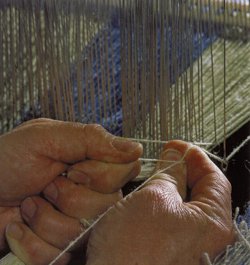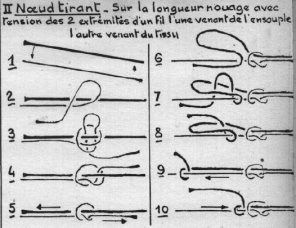- Home
- Resurrection ▾
-
Learn ▾
- Free library
- Glossary
- Documents
- Initiation
-
Shaped fabrics
- Introduction
- Popularization
- Definitions
- Le métier de façonné
- Principes du façonné
- Mécaniques de façonné
- Le jeu des crochets
- Les cartons
- Chaîne des cartons
- Mécanique 104 en détail
- Pour en finir
- Montage façonné
- Empoutage 1/3
- Empoutage 2/3
- Empoutage 3/3
- Punching, hanging and dip
- Autres façonnés
- Façonnés et Islam
-
Cours de tissage 1912
- Bâti d'un métier
- Le rouleau arrière
- Les bascules
- Formation du pas
- Position de organes
- Mécanique 104 Jacquard
- Fonctionnement 104
- Lisage des cartons
- Le battant du métier
- Le régulateur
- Réduction et régulateur
- Mise au métier d'une chaîne
- Mise en route du métier
- Navettes à soie
- Battage
- Ourdissage mécanique
- Préparation chaînes et trames
- Equipment ▾
- Chronicles ▾
- Fabrics ▾
- Techniques ▾
- Culture ▾
- Language ▾
Indeed, it is only a simple knot made on the black thread, into which the red thread is introduced. The end of each thread is then pulled between the thumb and the index finger of each hand to give the desired tension and then the two thread are clamped together on the right, between the right thumb and index finger, in order to block this tension and, with the left hand, the node is blocked as shown in step 9.
I have no doubt that after five minutes of training you will do it perfectly with great ease ...

Here is the pulling knot so precious to the weaver It is here broken down into 10 steps. This, at first glance, seems complex, but this is not the case if you observe the following sketch, which is the fourth step.

To tell you the truth, after the "tirelle", we weave a certain length, 30 or 50 cm as required, to make a sample of the fabric if it can be useful to us. Then we will advance the warp by 2 or 3 cm (which will not be woven) and we will weave again, normally this time 4 or 5 cm. We pass in the shed a rod of wood or iron of the width of the fabric plus 10 cm, and we will weave again a few centimeters.
It is then possible to relax the warp, cut it with a chisel in the nonwoven part, and attach the warp by its rod in the front beam.
Since I was weaving warps of silk organzine to make cut velvet or "satins grigné", I did not practice the knotting method but that of twisting (tordage).
It has, however, happened to me to weave schappe to make English gauze, mercerized cotton, or wool. In these cases I proceeded with a knotting to subdue the threads of the old warp to those of the new. Personally I have always used the pulling knot which is most used to weaving silk.
The pulling node makes it possible to adjust with precision the tension that one wants to give to the thread. It is of course necessary to be as regular as possible so that all the threads have the same tension at the end.
I take this opportunity to give you the following advice:
When you restart the weaving you will make what is called a "tirelle'. It is a strip of fabric about twenty centimeters that allows the threads of the new warp to regulate their tension, ie those who are distended will tighten to be as others.
For this you must weave the "tirelle" into a loose fabric. You weave a dozen wefts by pulling the batten without beating so that the wefts are not tightened (leave 1 mm between each weft). Then weave 4 wefts by beating very hard. Repeat the operation a few times and you will see that your warp threads will all have the same tension. Your "tirelle" will measure between 20 and 30 cm depending on the tension to be recovered.

The knotting
When we weave a new warp similar to the one we have just finished (new color for example) and using the same harness or set of shaft frames), we avoid the long and tedious operation of pass and that of the reeding by making the knotting.
The threads of the warp which is finished are tied one by one to those of the new warp.
